 W
WArchaeorhynchus is a genus of beaked avialan stem-birds from the early Cretaceous period. A fossil of its only known species, Archaeorhynchus spathula, was first reported in 2005 by Zhou & Zhang to have been found in Yixian Formation rocks at Yixian, Liaoning province, China, showing a well-preserved and essentially complete skeleton. Two more complete specimens were found in Lower Cretaceous deposits of Jianchang, Liaoning, northeastern China, preserving new anatomical information. These deposits are 120 million years old, whereas the original specimen was 125 million years old, meaning the age range for this species is 125-120Ma.
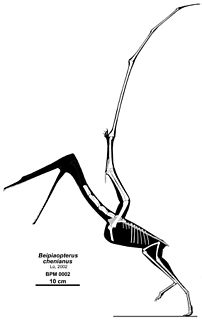 W
WBeipiaopterus is a genus of ctenochasmatid pterosaur from the Early Cretaceous period of what is now the Yixian Formation of the China.
 W
WBeipiaosaurus is a genus of therizinosauroid theropod dinosaurs that lived in Asia during the Early Cretaceous in the Yixian Formation. The first remains were found in 1996 and formally described in 1999. Before the discovery of Yutyrannus, they were among the largest dinosaurs known from direct evidence to be feathered. Beipiaosaurus is known from three reported specimens preserving numerous impressions of feather structures that allowed to determine the feathering color which turned out to be brownish.
 W
WBohaiornis is a genus of enantiornithean birds. Fossils have been found from the Lower Cretaceous Jiufotang Formation of western Liaoning, China. The only known species, Bohaiornis guoi, was named by Dongyu Hu, Li Li, Lianhaim Hou and Xing Xu in 2011 on the basis of a fully articulated and well-preserved skeleton of a sub-adult. This specimen, LPM B00167, preserved two long, ribbon-like feathers attached to the tail rather than a fan of shorter pennaceous feathers. It was similar to the slightly older Eoenantiornis, but much larger in size. Bohaiornis is the type species of Bohaiornithidae, a family of large predatory enantiornitheans from the Early Cretaceous.
 W
WBoreopteridae is a group of pterodactyloid pterosaurs from the Aptian-age Lower Cretaceous Yixian Formation of Liaoning, China.
 W
WCaudipteryx is a genus of peacock-sized theropod dinosaurs that lived in the Aptian age of the early Cretaceous Period. They were feathered and remarkably birdlike in their overall appearance. Two species have been described; C. zoui, in 1998, and C. dongi, in 2000.
 W
WChangchengornis is an extinct basal pygostylian genus from the Early Cretaceous. Its remains have been found in the People's Republic of China, in Chaomidianzi Formation rocks from around the Barremian-Aptian boundary, deposited 125 million years ago. Changchengornis was a close relative of the better-known Confuciusornis. In 1999 it was assigned to the Confuciusornithidae.
 W
WChangmiania is a genus of basal ornithopod dinosaur that lived in what is now China during the Early Cretaceous. It contains a single species, Changmiania liaoningensis.
 W
WConfuciusornis is a genus of primitive crow-sized avialan from the Early Cretaceous Period of the Yixian and Jiufotang Formations of China, dating from 125 to 120 million years ago. Like modern birds, Confuciusornis had a toothless beak, but close relatives of modern birds such as Hesperornis and Ichthyornis were toothed, indicating that the loss of teeth occurred convergently in Confuciusornis and living birds. It is the oldest known bird to have a beak. It was named after the Chinese moral philosopher Confucius. Confuciusornis is one of the most abundant vertebrates found in the Yixian Formation, and several hundred complete, articulated specimens have been found.
 W
WDaliansaurus is a genus of small troodontid theropod dinosaur, measuring approximately 1 metre long, from the Early Cretaceous of China. It contains a single species, D. liaoningensis, named in 2017 by Shen and colleagues from a nearly complete skeleton preserved in three dimensions. Daliansaurus is unusual in possessing an enlarged claw on the fourth digit of the foot, in addition to the "sickle claw" found on the second digit of the feet of most paravians. It also has long metatarsal bones, and apparently possesses bird-like uncinate processes. In the Lujiatun Beds of the Yixian Formation, a volcanically-influenced region with a cold climate, Daliansaurus lived alongside its closest relatives - Sinovenator, Sinusonasus, and Mei, with which it forms the group Sinovenatorinae.
 W
WDilong is a genus of basal tyrannosauroid dinosaur. The only species is Dilong paradoxus. It is from the Lower Cretaceous Yixian Formation near Lujiatun, Beipiao, in the western Liaoning province of China. It lived about 126 million years ago.
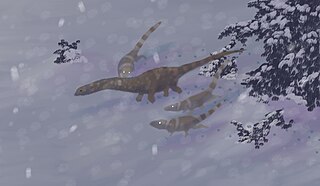 W
WDongbeititan is a genus of sauropod dinosaur from the Early Cretaceous-age Yixian Formation of Beipiao, Liaoning, China. It is based on holotype DNHM D2867, a partial postcranial skeleton including bones from the limbs, shoulder and pelvic girdles, and vertebrae. which was described in 2007 Its describers suggested it was as a basal titanosauriform, not as derived as Gobititan or Jiutaisaurus, but more derived than Euhelopus, Fusuisaurus, and Huanghetitan. The type species is D. dongi, and it is the first named sauropod from the Yixian Formation, which is part of the well-known Jehol Group. The genus name refers to the region Dongbei and to Greek titan, "giant". The specific name honours the Chinese paleontologist Dong Zhiming. Like other sauropods, Dongbeititan would have been a large quadrupedal herbivore.
 W
WEoenantiornis is a genus of enantiornithean birds which lived during the early Cretaceous period. It is known from a single fossil specimen found in the Yixian Formation in Liaoning province, China.
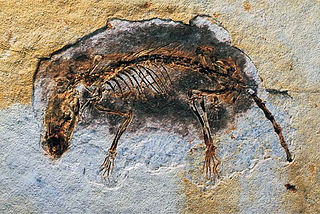 W
WEomaia is a genus of extinct fossil mammals containing the single species Eomaia scansoria, discovered in rocks that were found in the Yixian Formation, Liaoning Province, China, and dated to the Barremian Age of the Lower Cretaceous about 125 million years ago. The single fossil specimen of this species is 10 centimetres (3.9 in) in length and virtually complete. An estimate of the body weight is between 20–25 grams (0.71–0.88 oz). It is exceptionally well-preserved for a 125-million-year-old specimen. Although the fossil's skull is squashed flat, its teeth, tiny foot bones, cartilages and even its fur are visible.
 W
WEosipterus is an extinct genus of ctenochasmatid pterosaur from the Early Cretaceous period of Liaoning, China. Fossil remains of Eosipterus dated back to the Aptian stage of the Early Cretaceous, 124.6 million years ago.
 W
WEuhelopus is a genus of sauropod dinosaur that lived between 129 and 113 million years ago during the Early Cretaceous in what is now Shandong Province in China. It was a large quadrupedal herbivore. Unlike most other sauropods, Euhelopus had longer forelegs than hind legs. This discovery was paleontologically significant because it represented the first dinosaur scientifically investigated from China: seen in 1913, rediscovered in 1922, and excavated in 1923. Unlike most sauropod specimens, it has a relatively complete skull.
 W
WFeilongus is an extinct genus of ctenochasmatid pterodactyloid pterosaur from the Barremian-Aptian-age Lower Cretaceous Yixian Formation of Beipiao, Liaoning, China.
 W
WGladocephaloideus is a genus of ctenochasmatid ctenochasmatoid pterosaur from the Early Cretaceous period of what is now western Liaoning, China.
 W
WGraciliraptor is a genus of theropod dinosaur from the early Cretaceous Period. It is a microraptorine dromaeosaurid.
 W
WHaopterus is a genus of pterodactyloid pterosaur from the Barremian-Aptian-age Lower Cretaceous Yixian Formation of Liaoning, China. Its fossil remains dated back 124.6 million years ago.
 W
WHongshanornis is a genus of ornithuromorph birds known from early Cretaceous lake deposits of the Yixian Formation, Inner Mongolia, China. The holotype specimen, recovered in 2005, is currently held by the Institute of Vertebrate Paleontology and Paleoanthropology in Beijing. It was found in the Jianshangou fossil beds, dated to 124.6 million years ago. Three additional specimens have been reported, though only one of those has been definitively identified as belonging to Hongshanornis. This latter specimen was found in the Dawangzhangzi fossil beds, which are about 122 million years old.
 W
WHuaxiagnathus is a genus of theropod dinosaur from the Lower Cretaceous of China. It was a compsognathid, large for that group at about half a meter longer than Compsognathus and larger specimens of Sinosauropteryx, with the largest specimen about 1.8 meters in length.
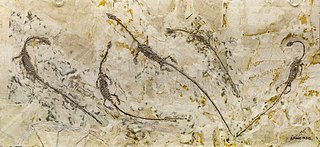 W
WHyphalosaurus is a genus of freshwater aquatic reptiles which represent a major part of the Jehol Biota. They lived during the early Cretaceous period, about 122 million years ago. The genus contains two species, H. lingyuanensis and H. baitaigouensis, both from the Yixian Formation of Liaoning Province, China. They are among the best-known animals from the Jehol Biota, with thousands of fossil specimens representing all growth stages in scientific and private collections.
 W
WIncisivosaurus is a genus of small, probably herbivorous theropod dinosaurs from the early Cretaceous Period of what is now the People's Republic of China. The first specimen to be described, IVPP V13326, is a skull that was collected from the lowermost levels of the Yixian Formation (dating to the Barremian stage about 126 million years ago in the Sihetun area, near Beipiao City, in western Liaoning Province. The most significant, and highly unusual, characteristic of this dinosaur is its apparent adaptation to an herbivorous or omnivorous lifestyle. It was named for its prominent, rodent-like front teeth, which show wear patterns commonly found in plant-eating dinosaurs. The specific name gauthieri honors Dr. Jacques Gauthier, a pioneer of the phylogenetic method of classification.
 W
WJeholodens was a primitive mammal belonging to the order Eutriconodonta, and which lived in present-day China during the Middle Cretaceous about 125 million years ago.
 W
WJeholops is an extinct genus of notostracan which existed in the Yixian Formation, inner Mongolia, China during the early Cretaceous period. It was described by Thomas A. Hegna and Ren Dong in 2010, and the only species is Jeholops hongi.
 W
WJeholosaurus is a genus of ornithischian dinosaur from the Early Cretaceous Period. It is thought to have been a herbivorous small ornithopod.
 W
WJianchangosaurus is a genus of therizinosaurian dinosaur that lived approximately 126 million years ago during the early part of the Cretaceous Period from the Yixian Formation in what is now China. The nearly complete juvenile specimen was missing only the distal tail. Jianchangosaurus was a small, lightly built, bipedal, ground-dwelling herbivore, that could grow up to an estimated 2 m (6.6 ft) long and was 1 m (3.3 ft) high at the hips.
 W
WJinzhousaurus is a genus of hadrosauroid dinosaur of the Early Cretaceous of China. The type species is Jinzhousaurus yangi. The generic name refers to the town Jinzhou. The specific name honours Yang Zhongjian as the founder of Chinese paleontology. It was first described by Wang Xiao-lin and Xu Xing in 2001.
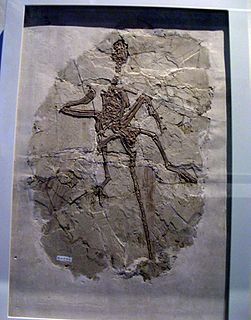 W
WJixiangornis is a genus of primitive euavialans from the Early Cretaceous. Like later avialans, it had no teeth, but it also had a long tail, unlike modern birds. Since teeth were still present in some more advanced short-tailed avialans, Jixiangornis seems to have evolved its toothlessness independently of modern birds. The long forelimb indicates at least some aerial ability. Jixiangornis is currently known only from a single specimen, a complete but juvenile skeleton. The fossil was found in the Yixian Formation near Beipiao City, western Liaoning, China.
 W
WLiaobatrachus is a genus of prehistoric spadefoot toads, the first fossil specimen of which was recovered from the Yixian Formation of Liaoning Province, China. It was the first Mesozoic era frog ever found in China. Later discoveries were named Callobatrachus sanyanensis and Mesophryne beipiaoensis until both were classified as synonymous with Liaobatrachus. It is a discoglossoid anuran. Fossils were found in the Sihetun locality of the western part of Liaoning province, in the lower part of the Yixian Formation, and date to approximately 124.6 Ma. Another specimen was collected near Heitizigou, 25 kilometres (16 mi) south of Beipiao. The specimen has a snout–vent length of 69 millimetres (2.7 in). Liaobatrachus is considered to be the most basal member of Discoglossidae based on phylogenetic analysis.
 W
WLiaoceratops, meaning "Liaoning horned face", is a ceratopsian dinosaur believed to be an early relative of the horned ceratopsids. It lived in the Early Cretaceous, 126 million years ago. It was discovered in China by a team of American and Chinese scientists. Liaoceratops was much smaller than its later relatives, but offers a glimpse into the early evolution of this group of dinosaurs.
 W
WLiaoningosaurus is an unusual genus of ankylosaurian dinosaurs from the Early Cretaceous period of China. It contains a single species, Liaoningosaurus paradoxus, and is represented by two fossil specimens collected from the Yixian Formation of Liaoning Province. L. paradoxus was unusual among advanced ornithischian dinosaurs in that it is speculated to have hunted or scavenged, with preserved gut contents showing that it may have eaten fish. Additionally, some features of its skeleton may suggest that it was partially aquatic.
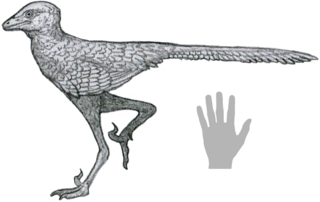 W
WLiaoningvenator is a genus of troodontid theropod dinosaur from the Early Cretaceous of China. It contains a single species, L. curriei, named after paleontologist Phillip J. Currie in 2017 by Shen Cai-Zhi and colleagues from an articulated, nearly complete skeleton, one of the most complete troodontid specimens known. Shen and colleagues found indicative traits that placed Liaoningvenator within the Troodontidae. These traits included its numerous, small, and closely packed teeth, as well as the vertebrae towards the end of its tail having shallow grooves in place of neural spines on their top surfaces.
 W
WLongirostravis is a genus of enantiornithean birds which existed during the early Cretaceous period and is known from fossils found in the middle or upper Yixian Formation in Yixian County, People's Republic of China. It is known from a single specimen housed in the collections of the Institute of Vertebrate Paleontology and Paleoanthropology representing the type species Longirostravis hani.
 W
WManchurochelys is an extinct genus of turtle in the order Paracryptodira. It existed during the early Cretaceous of what is now northeast China. It has been found in the Jianshangou Bed of West Liaoning's Yixian Formation. However, it is a rarely found fossil.
 W
WMei is a genus of duck-sized troodontid dinosaur first unearthed by paleontologists from the Yixian Formation in Liaoning, China in 2004. Mei lived during the Early Cretaceous period. The binomial name of its only species, Mei long, means sleeping dragon.
 W
WMonjurosuchus is a genus of choristoderan reptile that lived in what is now China and Japan during the Early Cretaceous. It has large eyes, a rounded skull, robust legs with short claws, and a long, thin tail. Fossils have been found that preserve soft tissue, showing that it had soft skin and webbed feet. Monjurosuchus has been placed in the family Monjurosuchidae along with Philydrosaurus, but the relationships of early choristoderes remains unclear.
 W
WNingchengopterus is a genus of pterodactyloid pterosaur from the Early Cretaceous (Aptian) Yixian Formation of China.
 W
WOdontomma is an extinct genus of Ommatine beetle. It is known from two species, O. sulcatum and O. trachylema, both known from the Aptian aged Yixian Formation of China. It is characterised by "moderately oval body, moderately more or less long and subparallel or oviform head with comparatively small eyes, rather wide pronotum with the widely explanate carinate sides, all veins ending on Sc along the lateral elytral edge, veins well expressed, explanate elytral sides with diffuse small microtubercles, and abdominal ventrites co-planar (abutting) or looking like bordered along the posterior edge." It is considered morphologically similar to Diluticupes.
 W
WOrdosemys is an extinct genus of sea turtle from the Cretaceous period.
 W
WPareuryomma is an extinct genus of Ommatine beetle. It is known from three species, P. angustum, P. cardiobasis and P. tylodes, all known from the Aptian aged Yixian Formation of China. The genus was first described in 2012, and formerly included the species Pareuryomma ancistrodonta from the Middle Jurassic Jiulongshan Formation, China, which was transferred to the genus Omma in 2020. The species P. angustum was formerly thought to be part of Brochocoleus. The genus is characterised by "slender body, long and subparallelsided or slightly narrowed head with moderately prominent eyes and more or less prominent temples, narrow pronotum with more or less explanate lateral carinae, elytra with the veins more or less well expressed and independently ending on Sc, large cells more or less arranged in rows on disc and moderately widely explanate sides of the elytra, and abdominal ventrites co-planar."
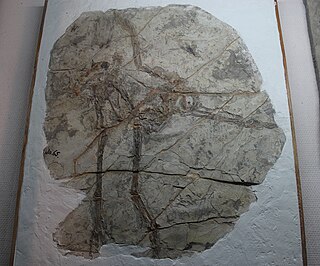 W
WProtarchaeopteryx is a genus of turkey-sized feathered theropod dinosaur from China. Known from the Jianshangou bed of the Yixian Formation, it lived during the early Aptian age of the Early Cretaceous, approximately 124.6 million years ago. It was probably an herbivore or omnivore, although its hands were very similar to those of small carnivorous dinosaurs. It appears to be one of the most basal members of the Oviraptorosauria, closely related to Incisivosaurus, or a taxon slightly less closely related to birds than oviraptorosaurs were.
 W
WPsittacosaurus is a genus of extinct ceratopsian dinosaur from the Early Cretaceous of what is now Asia, existing between 126 and 101 million years ago. It is notable for being the most species-rich dinosaur genus. Up to 12 species are known, from across China, Mongolia, Siberia, and possibly Thailand and Laos. The species of Psittacosaurus were obligate bipeds at adulthood, with a high skull and a robust beak. One individual was found preserved with long filaments on the tail, similar to those of Tianyulong, and scales across the rest of the animal. Psittacosaurus probably had complex behaviours, based on the proportions and relative size of the brain. It may have been active for short periods of time during the day and night, and had well-developed senses of smell and vision.
 W
WRepenomamus is a genus of opossum-sized to badger-sized gobiconodontid mammal containing two species, Repenomamus robustus and Repenomamus giganticus. Both species are known from fossils found in China that date to the early Cretaceous period, about 125-123.2 million years ago. R. robustus is one of several Mesozoic mammals for which there is good evidence that it fed on vertebrates, including dinosaurs, though it is not possible to determine if it actively hunted live dinosaurs or scavenged dead ones. R. giganticus is among the largest mammals known from the Mesozoic era.
 W
WShanweiniao is a genus of long-snouted enantiornithean birds from Early Cretaceous China. One species is known, Shanweiniao cooperorum. There is one known fossil, a slab and counterslab. The fossil is in the collection of the Dalian Natural History Museum, and has accession number DNHM D1878/1 and DNHM1878/2. It was collected from the Lower Cretaceous Dawangzhengzi Beds, middle Yixian Formation, from Lingyuan in the Liaoning Province, China.
 W
WShenzhousaurus is a genus of basal ornithomimosaur from the Lower Cretaceous of China.
 W
WSinobaatar is a genus of extinct mammal from the Lower Cretaceous of China. It is categorized within the also extinct order Multituberculata and among these it belongs to the plagiaulacid lineage. Sinobaatar was a small herbivore during the Mesozoic era, commonly called "the age of the dinosaurs". The genus was named by Hu Y. and Wang Y. in 2002. Three species have been described.
 W
WSinocalliopteryx is a genus of carnivorous compsognathid theropod dinosaurs from the Lower Cretaceous Yixian Formation of China.
 W
WSinornithosaurus is a genus of feathered dromaeosaurid dinosaur from the early Cretaceous Period of the Yixian Formation in what is now China. It was the fifth non–avian feathered dinosaur genus discovered by 1999. The original specimen was collected from the Sihetun locality of western Liaoning. It was found in the Jianshangou beds of the Yixian Formation, dated to 124.5 million years ago. Additional specimens have been found in the younger Dawangzhangzi bed, dating to around 122 million years ago.
 W
WSinosauropteryx is a compsognathid dinosaur. Described in 1996, it was the first dinosaur taxon outside of Avialae to be found with evidence of feathers. It was covered with a coat of very simple filament-like feathers. Structures that indicate colouration have also been preserved in some of its feathers, which makes Sinosauropteryx the first non-avialian dinosaurs where colouration has been determined. The colouration includes a reddish and light banded tail. Some contention has arisen with an alternative interpretation of the filamentous impression as remains of collagen fibres, but this has not been widely accepted.
 W
WSinovenator is a genus of troodontid dinosaur from China. It is from the early Cretaceous Period.
 W
WSinusonasus is a genus of dinosaurs from the Early Cretaceous Period, recovered from the Yixian Formation. It lived in what is now the Liaoning Province of China. Sinusonasus was a theropod, specifically a troodontid dinosaur.
 W
WTianyuraptor is a genus of short-armed dromaeosaurid dinosaur that lived during the Early Cretaceous, about 122 million years ago. Its remains have been found in western Liaoning, China. It was similar to other dromaeosaurids found in Liaoning, with the exception of being somewhat more primitive. The type specimen, formally named in 2009, shows features not seen in previously known Northern Hemisphere (Laurasian) dromaeosaurids, but present in Southern Hemisphere (Gondwanan) species and early birds. Because of this, the scientists who first studied Tianyuraptor described it as a "transitional species", bridging the gap between northern and southern types of dromaeosaurid. Tianyuraptor also differs from previously known dromaeosaurids in that it possesses a relatively small furcula ("wishbone"), and unusually short forelimbs.
 W
WXianglong is a genus of Cretaceous lizard discovered in the Zhuanchengzi, near Yizhou, Yixian, Liaoning Province of China. It is known from LPM 000666, a single complete skeleton with skin impressions. The specimen comes from the Barremian-age Lower Cretaceous Yixian Formation, near Yizhou. The most notable feature about Xianglong is its bizarre oversized ribs, eight on each side, which were attached to a membrane of body tissue and allowed the lizard to glide. It was an acrodont lizard, and a cladistic analysis indicates it was grouped with iguanians such as agamines, chamaeleonids, and leiolepidines.
 W
WYixianosaurus is a maniraptoran theropod dinosaur genus from the Early Cretaceous of China.
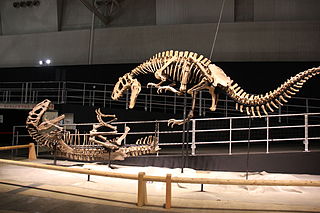 W
WYutyrannus is a genus of proceratosaurid tyrannosauroid dinosaur which contains a single known species, Yutyrannus huali. This species lived during the early Cretaceous period in what is now northeastern China. Three fossils of Yutyrannus huali—all found in the rock beds of Liaoning Province—are currently the largest-known dinosaur specimens that preserve direct evidence of feathers.
 W
WZhenyuanlong is a genus of dromaeosaurid dinosaur from the Yixian Formation of Liaoning, China. It lived during the Aptian age of the early Cretaceous period, approximately 125 million years ago. It is known from a single specimen belonging to the species Zhenyuanlong suni. This type specimen preserved a nearly complete skeleton that contains traces of feathers, including long tail feathers and large wings. In addition to further complicating diversity of Liaoning dromaeosaurids, this specimen provides the first evidence of well-developed pennaceous feathers in a large, non-flying dromaeosaur, raising the question of what function such wings would serve.
 W
WZhenyuanopterus is a genus of boreopterid pterosaur which is known from Lower Cretaceous Yixian Formation of Liaoning, China. It contains one species, Zhenyuanopterus longirostris, which was first described and named by Lü Junchang.